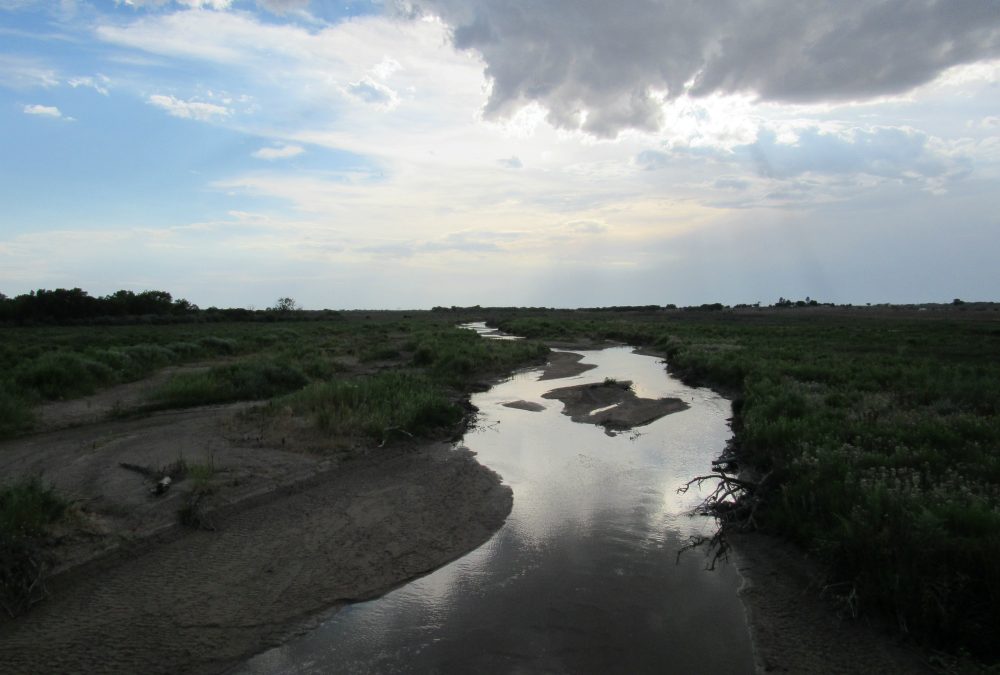A lake on Colorado’s southeastern plains whose salinity rivals that of the Great Salt Lake has residents of a small town ready to do battle with water officials over how to keep its alarmingly salty waters from reaching the Arkansas River.
The 250 or so residents of Lake Cheraw, the town that shares the lake’s name, want the lake to drain because they fear its salinity will damage their farms and homes. When lake levels rise, so do nearby water tables, seeping into basements and farm fields.
But draining the lake could cause salinity levels in the already salt-burdened Arkansas River to rise high enough to trigger potential legal battles with Kansas, which has a right to a portion of the river’s waters.
“How do we know this isn’t a lawsuit coming? Why even risk it?” – Mike Webber
The two states’ relationship with the river is governed by the much-litigated Arkansas River Compact and both states have spent tens of millions of dollars fighting over the water. The compact also dictates that water crossing the state line be “usable” for Kansas. Highly saline water is a concern because it can cause severe damage to crops.
“How do we know this isn’t a lawsuit coming?” says Mike Weber, an engineer with the Lower Arkansas Water Conservancy District. “Why even risk it?”
Lake Cheraw, according to most descriptions, is a natural low spot into which small amounts of irrigation water from nearby fields and reservoirs seep. Shale formations below the lake release salt when wet. The lake was dry through the early 2000s, but filled after large rain events in 2016 and 2017, according to Weber. Now, despite the drought, the lake has refilled and its salinity levels are topping 13,600 parts per million, according to recent sampling conducted by the water conservancy district.
Salinity levels on the Arkansas River at the Kansas state line hover around 4,000 ppm, less than one-third those of the lake currently. Salt isn’t a regulated contaminant, so prescribed standards on acceptable levels don’t exist. Still, water officials worry that if salinity rises above current levels, it could cause enough concern downstream to trigger lawsuits.
To cope with the lake’s recent rebirth, Lake Cheraw residents went to the Arkansas Basin Roundtable seeking a $21,000 grant to clear out a drainage below the lake that would allow the water to flow. Their grant request was denied, in part because of salinity concerns. Residents, according to Lake Cheraw Mayor Pro Tem Nick Koch, believe that with the drainage cleared, the water will drain slowly enough that its salinity levels will decline before reaching the Arkansas River, causing no noticeable increase there.
Water officials in the past, however have been reluctant to take that risk. Lake Cheraw was the subject of a state water quality rule known as Reg. 75 from the late 1980s through 2014 when it was repealed due to dry conditions—no releases were being made so the regulation was no longer needed. Reg. 75 dictated that water from the lake could only be released through a control structure and only in amounts that would keep salinity levels in the released water at or below 4,300 ppm.
Looking forward, management of Lake Cheraw could demand a new approach. The Lower Arkansas Water Conservancy District and others believe they could protect the Arkansas River and manage releases from Lake Cheraw by lining Holbrook Reservoir to prevent seepage into the lake; creating a natural, plant-based buffer between Lake Cheraw and the ditch that drains into the Arkansas River; and building a new control structure to manage releases.
This story originally appeared in Fresh Water News, an initiative of Water Education Colorado. Click Here to Read More Freshwater News


 Print
Print